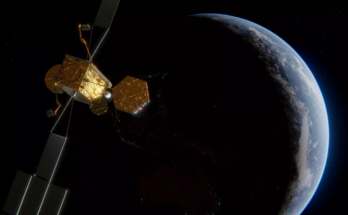by Bill Ostrove, Space Systems Analyst, Forecast International.
With its approval of SpaceX’s proposed constellation in late March, the Federal Communications Commission (FCC) has now approved the deployment of 5,264 small satellites from four companies to provide broadband communications services from Earth orbit.
The companies – OneWeb,[i] Space Norway,[ii] Telesat,[iii] and SpaceX[iv] – are four of 12 companies that have applied to deploy non-geostationary orbit (NGSO) satellite constellations. Combined, the 12 companies plan to deploy up to 8,811 satellites that will provide broadband communication services around the world. OneWeb was the first company to apply with the FCC to deploy its network. By November 15, 2016, all 12 had filed applications.[v]

The FCC has been going through the application backlog since then. Under Chairman Ajit Pai, the FCC has continued its emphasis on extending broadband connections to underserved areas of the U.S. As of 2016, over 24 million Americans lacked access to broadband with download speeds of at least 24 Mbps. In addition, in its 2018 broadband deployment report, the FCC found that broadband deployment was slowing, especially in rural areas and on Native American Tribal lands.[vi] In order to speed broadband deployment, the FCC is now encouraging satellite operators to expand broadband coverage over the U.S. The push at the FCC has coincided with a rush by entrepreneurs to develop and deploy new satellite systems, resulting in plans for thousands of satellites to be deployed in the near future.
OneWeb was the first of a new batch of companies to propose deploying massive networks of satellites in low-Earth orbit to provide broadband Internet. OneWeb is attempting to succeed where companies like Teledesic – which had similar plans in the late 1990s – failed when financing ran out during the dot-com bubble burst. OneWeb hopes the increased demand for broadband services, along with the miniaturization of components, will enable it to succeed. The company has the backing of investors, including space industry veterans like Intelsat and Airbus.
One major difference between the late 1990s and the current environment is that many incumbent satellite operators are now investing in NGSO networks. In the 1990s, geosynchronous satellite operators like Intelsat did not invest in NGSO startups. However, in this round, Intelsat, SES, Telesat, SKY Perfect JSAT, and ViaSat are all investing in NGSO companies or investing in their own NGSO networks. This investment from established companies is yet another sign of the industry’s optimism.
OneWeb has been joined by other companies like Space Norway, Telesat, and SpaceX in receiving approval to begin deploying their constellations. SpaceX’s plans are the most ambitious of those announced. The company, best known for operating its Falcon 9 launch vehicle, plans to deploy 4,425 satellites that will provide broadband services. SpaceX received permission to deploy its network from the FCC on March 30, 2018, bringing the total number of satellites approved for deployment by the FCC to 5,264. Two SpaceX “Starlink” satellites have already been deployed for testing.
Despite the optimism, questions remain about the future success of these systems. As noted earlier, companies have previously tried unsuccessfully to deploy massive constellations of satellites. The new entrants into the market will face strong competition from terrestrial networks, which don’t need to rely on expensive launch vehicles to deploy their equipment. Because the satellites don’t stay in one position over the ground like geosynchronous satellites do, operators of satellites in low-Earth orbit must deploy at least a few dozen satellites to provide global coverage. This means that even though each satellite is much cheaper than a geosynchronous satellite, the high number being deployed could add up. In addition, many of the satellites will be over the ocean or unpopulated areas at any given time, making them difficult to monetize.
The satellite companies will also be competing against each other. With all 12 companies that applied with the FCC competing over the same investors and customers, it is likely that many will fail. It remains to be seen which will be successful and which will not. However, companies that have made efforts to establish themselves early could have an advantage, since they have a head start gaining investors and customers. Companies like OneWeb and LeoSat have been successful in obtaining investors. Another company, Telesat, already has a network of geosynchronous satellites that are generating revenue, giving the Canadian company an advantage of its own.
The final major impediment to success is the ambitious timelines that companies must follow. In return for giving companies permission to deploy satellites and beam signals over the U.S., the FCC requires them to deploy at least half of their planned fleets within six years. Even though the satellites are smaller and easier to produce and launch than geosynchronous satellites, such a launch schedule will be a difficult task for companies planning to deploy hundreds or thousands of spacecraft in a relatively short timeframe. It is also possible that even if the companies are successful in gaining investors and customers, they may lose their licenses if they can’t keep up with their ambitious schedules.
Despite these hardships, the industry remains upbeat about its prospects. The demand for broadband Internet continues to grow. As consumers demand Internet service at all times, satellites have successfully filled gaps in terrestrial coverage by providing services to airlines and ships at sea. Demand will only continue to grow with new applications emerging as more devices are connected to the Internet. If satellite companies capture even a small percentage of the new business being generated by these new applications, many of the new satellite constellations will be successful. As a result, NGSO operators continue to make progress, as evidenced by the FCC’s recent approvals.
Please feel free to use this content with Forecast International and analyst attributions, along with a link to the article. Contact Ray Peterson at +1 (203) 426-0800 or via email at ray.peterson@forecast1.com for additional analysis.
Forecast International offers two Space Systems Forecast products: Launch Vehicles & Manned Platforms, with reports on manned spacecraft, expendable launch vehicles and more, and Satellites & Spacecraft, with coverage ranging from microsatellites to large COMSATs – all complete with technical specifications and forecast details.

[i] http://www.fcc.gov/document/fcc-grants-oneweb-us-access-broadband-satellite-constellation
[ii] http://www.fcc.gov/document/space-norway-ngso-market-access-grant
[iii] http://www.fcc.gov/document/telesat-ngso-market-access-grant
[iv] http://www.fcc.gov/document/fcc-authorizes-spacex-provide-broadband-satellite-services
[v] http://www.parabolicarc.com/2016/11/29/companies-propose-launching-8700-satellites-nongeosynchronous-orbit/
[vi] http://www.fcc.gov/reports-research/reports/broadband-progress-reports/2018-broadband-deployment-report
A military history enthusiast, Richard began at Forecast International as editor of the World Weapons Weekly newsletter. As the Internet grew in importance as a research tool, he helped design the company's Forecast Intelligence Center and currently coordinates the EMarket Alert newsletters for clients. Richard also manages social media efforts, including two new blogs: Defense & Security Monitor, covering defense systems and international issues, and Flight Plan, which focuses on commercial aviation and space systems. For over 30 years, Richard has authored the Defense & Aerospace Companies, Volume I (North America) and Volume II (International) services. The two books provide detailed data on major aerospace and defense contractors. He also edits the International Contractors service, a database that tracks all the contractors involved in the programs covered in the FI library. More recently he was appointed Manager, Information Services Group (ISG), a new unit that encompasses developing outbound content for both Forecast International and Military Periscope.



